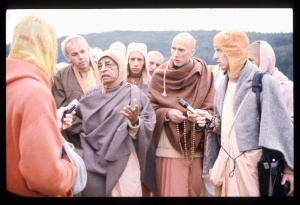CC Adi 14.32 (1975): Difference between revisions
(Vanibot #0027: CCMirror - Mirror CC's 1996 edition to form a basis for 1975) |
(Vanibot #0020: VersionCompareLinker - added a link to the Version Compare feature) |
||
| Line 2: | Line 2: | ||
<div style="float:left">'''[[Sri Caitanya-caritamrta (1975)|Śrī Caitanya-caritāmṛta (1975)]] - [[CC Adi (1975)|Ādi-līlā]] - [[CC Adi 14 (1975)|Chapter 14: Lord Caitanya's Childhood Pastimes]]'''</div> | <div style="float:left">'''[[Sri Caitanya-caritamrta (1975)|Śrī Caitanya-caritāmṛta (1975)]] - [[CC Adi (1975)|Ādi-līlā]] - [[CC Adi 14 (1975)|Chapter 14: Lord Caitanya's Childhood Pastimes]]'''</div> | ||
<div style="float:right">[[File:Go-previous.png|link=CC Adi 14.31 (1975)|Ādi-līlā 14.31]] '''[[CC Adi 14.31 (1975)|Ādi-līlā 14.31]] - [[CC Adi 14.33 (1975)|Ādi-līlā 14.33]]''' [[File:Go-next.png|link=CC Adi 14.33 (1975)|Ādi-līlā 14.33]]</div> | <div style="float:right">[[File:Go-previous.png|link=CC Adi 14.31 (1975)|Ādi-līlā 14.31]] '''[[CC Adi 14.31 (1975)|Ādi-līlā 14.31]] - [[CC Adi 14.33 (1975)|Ādi-līlā 14.33]]''' [[File:Go-next.png|link=CC Adi 14.33 (1975)|Ādi-līlā 14.33]]</div> | ||
{{CompareVersions|CC|Adi 14.32|CC 1975|CC 1996}} | |||
{{RandomImage}} | {{RandomImage}} | ||
==== TEXT 32 ==== | ==== TEXT 32 ==== | ||
<div class="verse"> | <div class="verse"> | ||
:māṭira vikāra ghaṭe pāni | :māṭira vikāra ghaṭe pāni bhari' āni | ||
:māṭi-piṇḍe dhari yabe, | :māṭi-piṇḍe dhari yabe, śoṣi' yāya pāni" | ||
</div> | </div> | ||
| Line 18: | Line 17: | ||
<div class="synonyms"> | <div class="synonyms"> | ||
māṭira—of the dirt; vikāra—transformation; ghaṭe—in the waterpot; pāni—water; | māṭira—of the dirt; vikāra—transformation; ghaṭe—in the waterpot; pāni—water; bhari'-filling; āni—I can bring; māṭi—of dirt; piṇḍe—on the lump; dhari—I hold; yabe—when; śoṣi'-soaking; yāya—goes; pāni—the water. | ||
</div> | </div> | ||
| Line 25: | Line 24: | ||
<div class="translation"> | <div class="translation"> | ||
"In a waterpot, which is a transformation of dirt, I can bring water very easily. But if I poured water on a lump of dirt, the lump would soak up the water, and my labor would be useless." | |||
</div> | </div> | ||
| Line 32: | Line 31: | ||
<div class="purport"> | <div class="purport"> | ||
This simple philosophy propounded by Śacīmātā, even though she is a woman, can defeat the Māyāvādī philosophers who speculate on oneness. The defect of Māyāvāda philosophy is that it does not accept the variety that is useful for practical purposes. Śacīmātā gave the example that although | This simple philosophy propounded by Śacīmātā, even though she is a woman, can defeat the Māyāvādī philosophers who speculate on oneness. The defect of Māyāvāda philosophy is that it does not accept the variety that is useful for practical purposes. Śacīmātā gave the example that although both the lump of dirt and the earthen pot are basically one, for practical purposes the waterpot is useful whereas the lump of dirt is useless. Sometimes scientists argue that matter and spirit are one, with no difference between them. Factually, in a higher sense, there is no difference between matter and spirit, but one should have practical knowledge that matter, being an inferior state, is useless for our spiritual, blissful life, whereas spirit, being a finer state of existence, is full of bliss. In this connection the Bhāgavatam gives the example that dirt and fire are practically one and the same. From the earth grow trees, and from their wood come fire and smoke. Nevertheless, for heat we can utilize the fire but not the earth, smoke or wood. Therefore, for the ultimate realization of the goal of life, we are concerned with the fire of the spirit, but not the dull wood or earth of matter. | ||
</div> | </div> | ||
Latest revision as of 15:19, 26 January 2020

A.C. Bhaktivedanta Swami Prabhupada
TEXT 32
- māṭira vikāra ghaṭe pāni bhari' āni
- māṭi-piṇḍe dhari yabe, śoṣi' yāya pāni"
SYNONYMS
māṭira—of the dirt; vikāra—transformation; ghaṭe—in the waterpot; pāni—water; bhari'-filling; āni—I can bring; māṭi—of dirt; piṇḍe—on the lump; dhari—I hold; yabe—when; śoṣi'-soaking; yāya—goes; pāni—the water.
TRANSLATION
"In a waterpot, which is a transformation of dirt, I can bring water very easily. But if I poured water on a lump of dirt, the lump would soak up the water, and my labor would be useless."
PURPORT
This simple philosophy propounded by Śacīmātā, even though she is a woman, can defeat the Māyāvādī philosophers who speculate on oneness. The defect of Māyāvāda philosophy is that it does not accept the variety that is useful for practical purposes. Śacīmātā gave the example that although both the lump of dirt and the earthen pot are basically one, for practical purposes the waterpot is useful whereas the lump of dirt is useless. Sometimes scientists argue that matter and spirit are one, with no difference between them. Factually, in a higher sense, there is no difference between matter and spirit, but one should have practical knowledge that matter, being an inferior state, is useless for our spiritual, blissful life, whereas spirit, being a finer state of existence, is full of bliss. In this connection the Bhāgavatam gives the example that dirt and fire are practically one and the same. From the earth grow trees, and from their wood come fire and smoke. Nevertheless, for heat we can utilize the fire but not the earth, smoke or wood. Therefore, for the ultimate realization of the goal of life, we are concerned with the fire of the spirit, but not the dull wood or earth of matter.